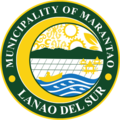Marantao مارانتاو | |
|---|---|
| Municipality of Marantao | |
 Map of Lanao del Sur with Marantao highlighted | |
 Interactive map of Marantao | |
Location within the Philippines | |
| Coordinates: 7°57′00″N124°13′59″E / 7.95°N 124.233°E | |
| Country | Philippines |
| Region | Bangsamoro Autonomous Region in Muslim Mindanao |
| Province | Lanao del Sur |
| District | 1st district |
| Barangays | 34 (see Barangays) |
| Government | |
| • Type | Sangguniang Bayan |
| • Mayor | Akira I. Alonto |
| • Vice Mayor | Nashriph B. Cornell |
| • Representative | Ziaur-Rahman A. Adiong |
| • Municipal Council | Members |
| • Electorate | 36,147 voters (2025) |
| Area | |
• Total | 660.00 km2 (254.83 sq mi) |
| Elevation | 795 m (2,608 ft) |
| Highest elevation | 1,171 m (3,842 ft) |
| Lowest elevation | 696 m (2,283 ft) |
| Population (2024 census) [3] | |
• Total | 46,233 |
| • Density | 70.050/km2 (181.43/sq mi) |
| • Households | 5,909 |
| Economy | |
| • Income class | 2nd municipal income class |
| • Poverty incidence | 26.27 |
| • Revenue | ₱ 342.6 million (2022) |
| • Assets | ₱ 92.32 million (2022) |
| • Expenditure | ₱ 322.9 million (2022) |
| • Liabilities | ₱ 1.565 million (2022) |
| Service provider | |
| • Electricity | Lanao del Sur Electric Cooperative (LASURECO) |
| Time zone | UTC+8 (PST) |
| ZIP code | 9711 |
| PSGC | |
| IDD : area code | +63 (0)63 |
| Native languages | Maranao Tagalog |
| Website | www |
Marantao, officially the Municipality of Marantao (Maranao: Inged a Marantao; Tagalog : Bayan ng Marantao), is a municipality in the province of Lanao del Sur, Philippines. According to the 2020 census, it has a population of 37,763 people. [5]
Contents
Marantao (Merantau) is a Malay word that means "to go on adventure, travel or hunting or even on a war expedition".


